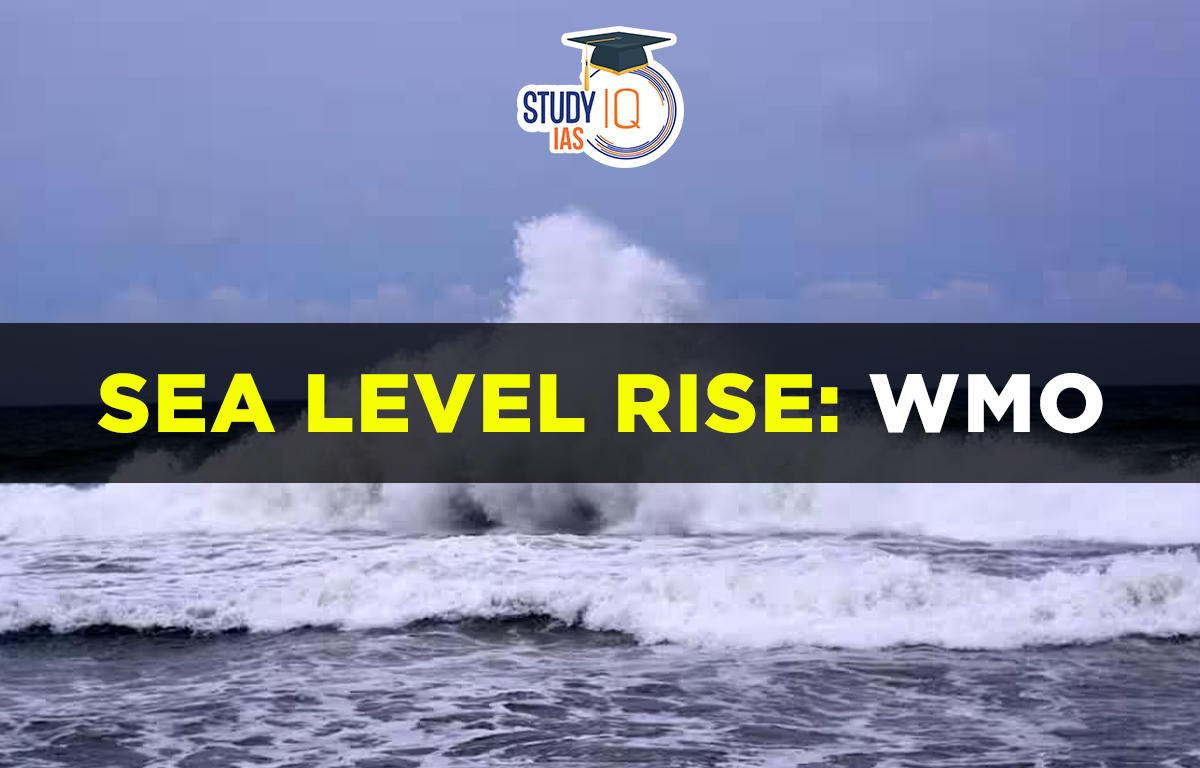Table of Contents
Context: According to the recent WMO report “Global Sea-Level Rise and Implications Key facts and figures”, sea level rise is a major threat for India and China along with Bangladesh, the Netherlands and other countries which have large coastal populations.
Key Highlights of the Report
- Sea Level Rise: Global mean sea-level increased by 0.20m between 1901 and 2018, with an average rate increase of 1.3 mm/ year between 1901 and 1971,1.9 mm/year between 1971 and 2006, and 3.7 mm/year between 2006 and 2018.
- Between 2013 and 2022, this has been 4.5 mm/yr and human influence was very likely the main driver of these increases since at least 1971.
- Global Warming/Rising Temperature: It noted that even if global heating is limited to 1.5 degrees Celsius (over pre-industrial levels), there will still be a sizeable sea level rise.
- If temperatures rise by 2 degrees, that level rise could double, with further temperature increases bringing exponential sea level increases.
- Under any scenario, countries like Bangladesh, China, India and the Netherlands are all at risk.
- At sustained warming levels between 2 and 3 degree C, the Greenland and West Antarctic ice sheets will be almost completely and irreversibly lost, causing potentially multi-meter sea-level rise.
- This will cause massive economic losses and coastal flooding in regions with high coastal populations.
- Thermal Expansion: Thermal expansion contributed to 50% of sea level rise.
- During 1971-2018 ice loss from glaciers contributed to 22% of sea level rise.
- This rate increased by a factor of four between 1992-1999 and 2010-2019.
- Global Emission and Sea Level Rise: The report noted that sea levels will continue to rise in all emission scenarios.
- The likely global mean sea level rise by 2100 is 0.28-0.55 m under the very low GHG (green house gas) emissions scenario; 0.44-0.76 m under the intermediate GHG emissions scenario and 0.63-1.01 m under the very high emissions scenario.
- Coastal Flooding: The population potentially exposed to a 100-year coastal flood is projected to increase by about 20% if global mean sea level rises by 0.15 m relative to 2020 levels.
- This exposed population doubles at a 0.75 m rise in mean sea level and triples at 1.4 m.
- There will be cascading and compounding impacts resulting in losses of coastal ecosystems and ecosystem services, groundwater salinization, flooding and damage to coastal infrastructure.
- Impact on India: India is most vulnerable to compounding impacts of sea level rise.
- The report warned about the large-scale impacts on Mumbai, Chennai, Kolkata and other coastal cities in the country.
- In the Indian Ocean, half of sea level rise is due to the volume of water expanding since the ocean is warming up rapidly.
- The contribution from glacier melt is not as high. Indian Ocean is the fastest warming ocean in terms of surface warming.
- The impact India is facing is due to compound extreme events along our coastline.
- Cyclones are intensifying rapidly due to more moisture and heat from ocean warming.
- The amount of flooding also increases because storm surges are compounding sea level rise decade by decade.
- Cyclones are bringing more rain than earlier. This can damage agriculture in the region for years and decades.
- Himalayan melts have worsened flooding in Pakistan.
- But as these glaciers recede over time, the Indus, Ganges and Brahmaputra rivers will shrink. And rising sea levels will make large parts of their huge deltas uninhabitable.
- Global Impact: Mega-cities on every continent will face serious impacts including Cairo, Lagos, Maputo, Bangkok, Dhaka, Jakarta, Mumbai, Shanghai, Copenhagen, London, Los Angeles, New York, Buenos Aires and Santiago.
- The danger is especially acute for nearly 900 million people who live in coastal zones at low elevations.
Sea Level Rise
Sea level rise is an increase in the level of the world’s oceans due to the effects of global warming.
The Key Causes Include:
- Ocean expansion: Burning Fossil Fuels releases heat-trapping gases into the atmosphere, which are absorbed majorly by oceans, causing the warmer water in oceans to expand and rise.
- Melting of ice cap: With the average year-round global temperatures rising, ice caps and glaciers are experiencing a disproportionate amount of melting at an accelerated rate.
Consequences of Sea-level Rise:
- Damage coastal areas: Increased intensity of storm surges, flooding, and damage to coastal areas.
- Displacement of communities: Threat to life in coastal areas, and their displacement to seek safer homes.
- Land contamination: Contamination of soil and groundwater with salt.
Mitigation Strategies Include:
- Building flood barriers to protect infrastructure
- Relocate facilities to higher elevations
- Allow coastal wetlands to migrate inland (e.g., through setbacks, density restrictions land purchases)
- Remove hard protection or other barriers to tidal and riverine flow (e.g., riverine and tidal dike removals)
- Incorporate sea level rise into planning for new infrastructure (e.g., sewage systems)
- Integrated Coastal Zone Management – using an integrated approach to achieve sustainability.



 Daily Quiz 03 July 2025
Daily Quiz 03 July 2025
 Dalai Lama Confirms He will have a Succe...
Dalai Lama Confirms He will have a Succe...
 List of Awards and Honours Received by N...
List of Awards and Honours Received by N...





















